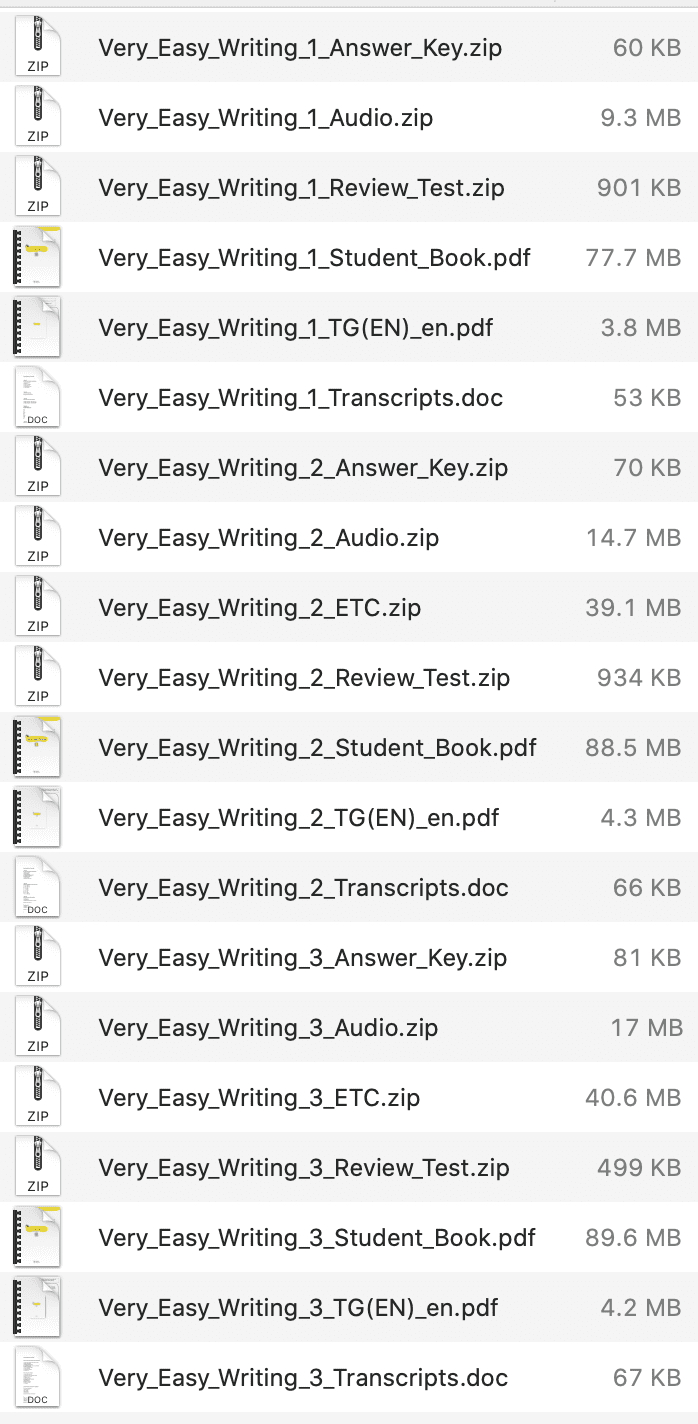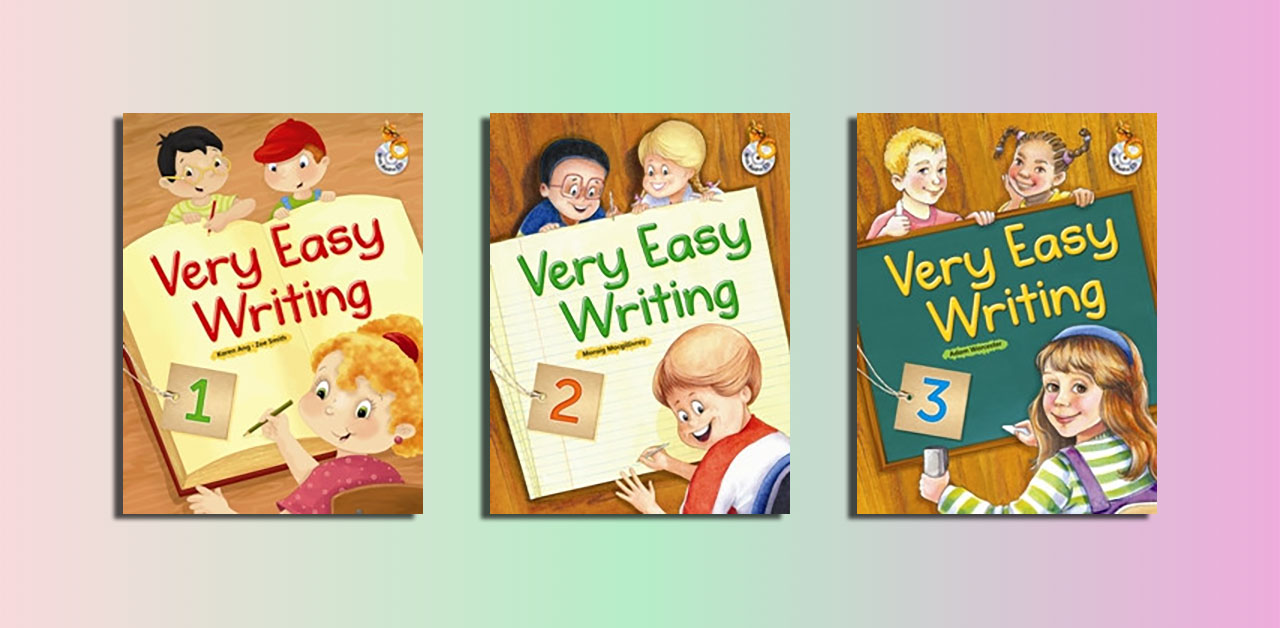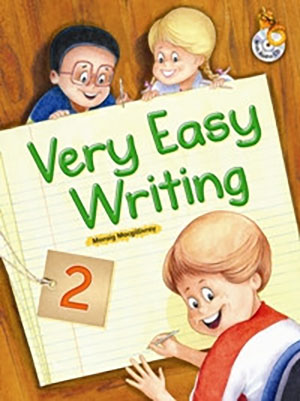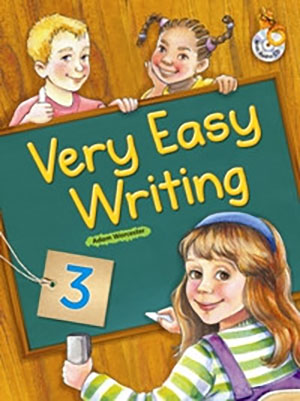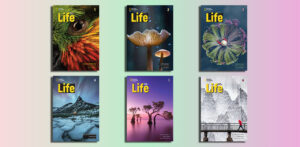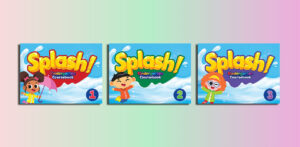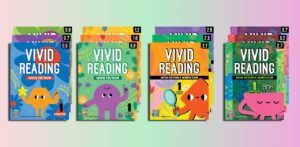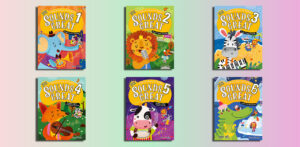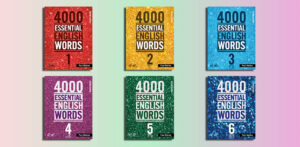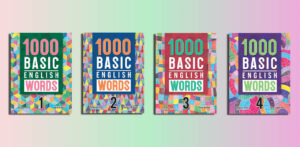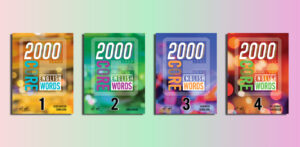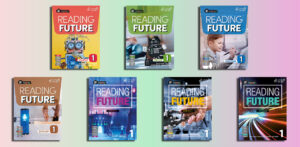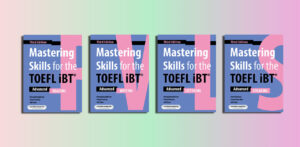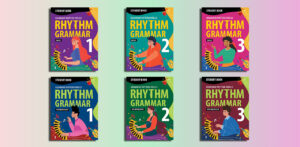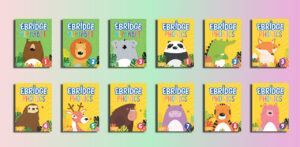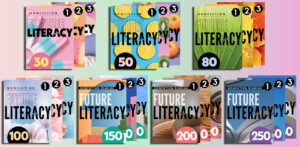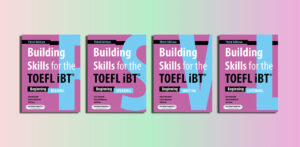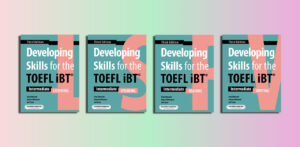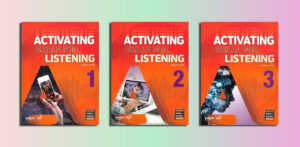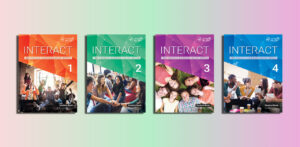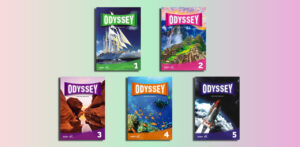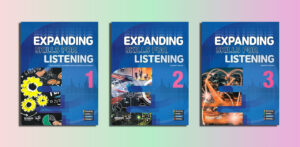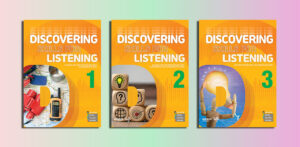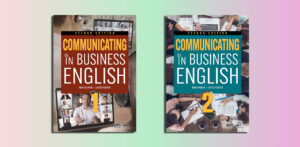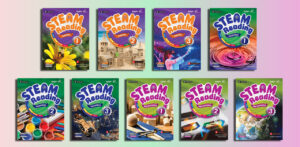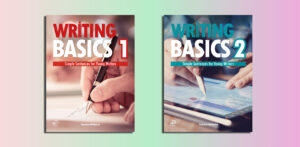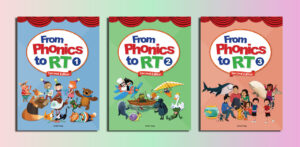Very Easy Writing (PDFs, Resources)
Level 1 (Pre A1)
Answer Key – Audio – Review Test – Student Book – TG – Transcripts
Very Easy Writing 1 Student Book.pdf – Sample: Click
Level 2 (Pre A1 / A1)
Answer Key – Audio – Review Test – Student Book – TG – Transcripts
Very Easy Writing 2 Student Book.pdf – Sample: Click
Level 3 (A1)
Answer Key – Audio – Review Test – Student Book – TG – Transcripts
Very Easy Writing 2 Student Book.pdf – Sample: Click
Compass Writing Series
Very Easy Writing (Pre A1): Click here
Guided Writing (Pre A1 / A1): Click here
Guided Writing Plus (A1+ / A2+): Click here
| Name | Price | Buy |
|---|---|---|
| Very Easy Writing 1 (PDFs, Resources) | $5 | |
| Very Easy Writing 2 (PDFs, Resources) | $5 | |
| Very Easy Writing 3 (PDFs, Resources) | $5 | |
| Very Easy Writing - All 3 Levels (PDFs, Resources) | $12 |
Overview of the “Very Easy Writing” by Compass Publishing
Contents
| ✅ Coursebook: | Very Easy Writing |
| ✅ Authors: | Karen Ang, Zoe Smith, Moraig Macgillivray, Adam Worcester |
| ✅ Publisher: | Compass Publishing |
| ✅ English type: | International English |
| ✅ Levels: | Pre A1 |
| ✅ Skill: | Writing |
| ✅ For: | Primary |
| ✅ Publication year: | 2012 |
The Very Easy Writing series by Compass Publishing is a thoughtfully designed English language learning resource tailored for young, low-elementary learners. This three-level course aims to build a solid foundation in writing skills, guiding students from letter recognition to crafting independent sentences. With a focus on accessibility and engagement, the series is ideal for beginner English learners, aligning with CEFR Pre-A1 levels. Below is an overview of its structure, key features, and supplementary materials, highlighting why it’s a valuable tool for educators and students alike.
Purpose and Structure
The Very Easy Writing series is structured to progressively develop writing skills across three levels:
- Book 1: Focuses on the letter level, helping students build confidence in writing individual letters and simple words.
- Book 2: Emphasizes correct spelling and word placement within sentences, introducing basic sentence construction.
- Book 3: Advances to producing independent sentences with an increased awareness of English grammar patterns.
Each level is designed to be easy to approach, ensuring young learners feel supported as they develop foundational writing skills. The series integrates reading, writing, and comprehension activities to reinforce learning in a holistic way.
Key Features
The Very Easy Writing series stands out for its student-friendly design and comprehensive support materials:
- Easy-to-Follow Student Book: Full-color illustrations and photographs make the content visually appealing and engaging. Clear instructions guide students through each task.
- Detachable Workbook: Provides extra practice for in-class activities or homework, including tracing exercises, sentence writing, and drawing tasks to reinforce concepts.
- Textual and Graphic Comprehension Activities: Activities combine text and visuals to enhance understanding and retention of vocabulary and grammar.
- High-Frequency Vocabulary: Methodical repetition of commonly used words helps students build a strong vocabulary base.
- Audio CD: Includes native English speaker pronunciations of key words and phrases, supporting listening and speaking skills.
- Accessible Appendix: A reference section in the student book provides quick access to key concepts for review.
- Interactive Hybrid CD: Offers digital activities like tracing pronouns, using “to be” verbs, and practicing negative sentences (e.g., “is not”).
These features ensure that students remain engaged while developing writing proficiency through repetition and varied activities.
Unit Walkthrough
Each unit in the Very Easy Writing series follows a structured approach to maximize learning:
- Presentation & Practice: Introduces key vocabulary and sentence structures through dialogues and practice exercises.
- Put It Together: Students use provided vocabulary to identify objects and form simple sentences based on pictures.
- Structure: Focuses on specific grammar points, such as using the correct form of the “to be” verb or pronouns, with visual prompts.
- My Writing Project: Encourages creativity by having students draw pictures (e.g., themselves in preferred clothing) and write about them using taught vocabulary and structures.
- Trace and Write: Workbook activities involve tracing and writing pronouns or sentences to improve motor skills and reinforce learning.
This methodical structure scaffolds learning, ensuring students build confidence as they progress.
Supplementary Materials
The series is supported by a robust set of online and downloadable resources, making it versatile for classroom and home use:
- Teacher’s Guide: A free downloadable guide offers lesson plans, teaching tips, and additional activity ideas.
- Unit Tests: Downloadable tests for each unit allow educators to assess student progress.
- Answer Keys and Transcripts: Provide quick reference for workbook activities and audio content.
- Audio Tracks: Available for streaming on platforms like SoundCloud, these tracks support pronunciation and listening practice.
- Optional e-Tutor Program: Compass Publishing’s online platform offers additional digital practice to complement the series.
These resources make the series adaptable for various teaching environments, from traditional classrooms to remote learning.
Target Audience and Benefits
The Very Easy Writing series is designed for young learners at the low-elementary level, particularly those new to English. Its CEFR Pre-A1 alignment ensures it meets the needs of beginners, while its engaging visuals and interactive components keep students motivated. The series benefits:
- Students: Builds confidence in writing through clear, repetitive, and creative tasks.
- Teachers: Provides comprehensive support with ready-to-use materials and flexible digital tools.
- Parents: Offers accessible homework activities to reinforce classroom learning.
By focusing on foundational skills like letter formation, spelling, and sentence structure, the series lays the groundwork for long-term English proficiency.
Conclusion
The Very Easy Writing series by Compass Publishing is an excellent resource for young English learners, offering a structured, engaging, and supportive approach to writing instruction. With its vibrant student books, practical workbooks, and extensive digital supplements, it caters to diverse learning needs while fostering creativity and confidence. Educators and parents looking for an accessible, high-quality writing course will find this series a valuable addition to their toolkit.
Very Easy Writing 1
Who is suitable for “Very Easy Writing”?
The Very Easy Writing series by Compass Publishing is suitable for young, low-elementary English learners at the CEFR Pre-A1 level. It is ideal for:
- Beginner students: Children new to English, typically in early primary school, who need to develop foundational writing skills like letter formation, spelling, and basic sentence construction.
- ESL/EFL learners: Non-native English speakers requiring a structured, engaging introduction to writing.
- Classroom and homeschool settings: Teachers and parents seeking accessible, visually appealing materials with clear instructions and supplementary resources like workbooks and audio CDs.
- Learners needing reinforcement: Students who benefit from repetitive, high-frequency vocabulary and creative tasks to build confidence in writing.
The series’ full-color illustrations, simple activities, and supportive tools make it perfect for young learners starting their English writing journey.
The benefits of “Very Easy Writing”
The Very Easy Writing series by Compass Publishing offers numerous benefits for young, low-elementary English learners, teachers, and parents:
- Builds Foundational Writing Skills: Guides students from letter formation (Book 1) to spelling and word placement (Book 2) and independent sentence creation (Book 3), fostering a strong writing foundation.
- Engages Young Learners: Full-color illustrations, photographs, and interactive tasks like drawing and writing projects keep students motivated and interested.
- Enhances Vocabulary and Grammar: Methodical repetition of high-frequency words and clear grammar exercises (e.g., pronouns, “to be” verbs) improve language retention and understanding.
- Supports Holistic Learning: Integrates reading, writing, listening (via Audio CD), and comprehension activities to reinforce skills across multiple domains.
- Boosts Confidence: Easy-to-follow instructions and scaffolded activities ensure students progress steadily, building confidence in their abilities.
- Provides Flexible Resources: Includes detachable workbooks, downloadable teacher’s guides, unit tests, answer keys, and an interactive Hybrid CD, making it adaptable for classroom, homeschool, or remote learning.
- Encourages Creativity: “My Writing Project” activities allow students to draw and write about personal topics, fostering creativity alongside technical skills.
- Accessible for Beginners: Aligned with CEFR Pre-A1, the series is designed for young learners new to English, with clear, supportive materials.
- Saves Teacher Preparation Time: Comprehensive supplementary materials, like lesson plans and audio tracks, streamline lesson planning and assessment.
These benefits make Very Easy Writing an effective, engaging tool for developing English writing proficiency in young learners while supporting educators and parents.
Very Easy Writing 2
Effective learning strategies for “Very Easy Writing”
To maximize the effectiveness of the Very Easy Writing series by Compass Publishing for young, low-elementary English learners, educators and parents can implement the following learning strategies tailored to the series’ structure and resources:
Leverage the Scaffolded Structure:
- Start Sequentially: Begin with Book 1 for letter recognition and progress to Books 2 and 3 for spelling and sentence formation, ensuring students master foundational skills before advancing.
- Follow Unit Flow: Use the series’ unit structure—Presentation, Practice, Put It Together, Structure, and My Writing Project—to guide lessons. Reinforce each step before moving to the next to build confidence.
Incorporate Multisensory Learning:
- Use the Audio CD: Play native speaker pronunciations to enhance listening and speaking skills, helping students connect written words with sounds.
- Tracing and Drawing: Encourage students to complete workbook tracing exercises and drawing tasks (e.g., in My Writing Project) to engage tactile and visual learning, reinforcing motor skills and creativity.
- Visual Aids: Point out illustrations and photographs in the student book during lessons to aid vocabulary comprehension and contextual understanding.
Reinforce Vocabulary Through Repetition:
- High-Frequency Words: Create flashcards or word walls using the series’ high-frequency vocabulary to promote memorization through daily review.
- Contextual Practice: Have students use vocabulary in sentences during the “Put It Together” activities, reinforcing word usage in meaningful contexts.
Encourage Active Participation:
- Group Activities: Pair students for dialogue practice or sentence-building tasks, fostering collaboration and oral reinforcement of written skills.
- Creative Expression: In the “My Writing Project” section, allow students to share their drawings and sentences with peers, boosting engagement and confidence.
Utilize Supplementary Resources:
- Interactive Hybrid CD: Assign digital activities (e.g., tracing pronouns, practicing “to be” verbs) as homework or in-class tasks to reinforce concepts through technology.
- Teacher’s Guide: Use the downloadable guide for lesson plans and activity ideas to structure classes effectively and save preparation time.
- Unit Tests: Administer downloadable tests to assess progress and identify areas needing review, tailoring instruction to student needs.
Promote Consistent Practice:
- Daily Writing Tasks: Assign short workbook exercises (e.g., tracing or sentence completion) as daily homework to reinforce skills through repetition.
- Review Sessions: Use the student book’s appendix for quick reviews of key concepts, ensuring retention before introducing new material.
Differentiate Instruction:
- Support Struggling Learners: Provide extra tracing practice or one-on-one guidance during workbook activities for students who need more support with motor skills or vocabulary.
- Challenge Advanced Students: Encourage early finishers to write additional sentences or create mini-stories using vocabulary from the unit, extending their learning.
Integrate Technology:
- e-Tutor Program: If available, use Compass Publishing’s optional online platform for additional digital practice, keeping students engaged with interactive content.
- Audio Streaming: Access audio tracks on platforms like SoundCloud for listening practice during class or at home, especially for pronunciation reinforcement.
Foster a Positive Learning Environment:
- Celebrate Progress: Display completed “My Writing Project” work or praise correct sentences to build confidence and motivation.
- Make It Fun: Incorporate games like vocabulary bingo or sentence-building races using the series’ words to keep lessons lively and engaging.
Engage Parents for Reinforcement:
- Homework Guidance: Share workbook activities with parents, explaining how to support tracing or sentence-writing tasks at home.
- Audio Access: Encourage parents to play Audio CD tracks or streamed audio to reinforce pronunciation and listening skills outside the classroom.
By combining these strategies, educators and parents can fully harness the Very Easy Writing series’ engaging materials and structured approach to help young learners develop strong writing skills, confidence, and a love for English learning.
Very Easy Writing 3
Effective teaching strategies for “Very Easy Writing”
Very Easy Writing by Compass Publishing is a three-level series designed to teach young, low-elementary English learners the fundamentals of writing, from letter formation to crafting simple sentences. To maximize the effectiveness of this series in the classroom or at home, educators and parents can employ targeted teaching strategies that align with the program’s structure and cater to young learners’ needs. Below are practical, evidence-based strategies to enhance engagement, comprehension, and skill development when using Very Easy Writing.
1. Leverage Multisensory Learning
Very Easy Writing incorporates visuals, audio, and hands-on activities, making it ideal for multisensory teaching approaches.
Strategy: Combine visual, auditory, and kinesthetic activities to reinforce concepts. For example:
- Visual: Use the colorful illustrations in the student book to introduce vocabulary. Point to pictures and ask students to name objects or describe them using target words.
- Auditory: Play the included audio CD or stream tracks from Compass Publishing’s website to model correct pronunciation. Have students repeat words or sentences aloud to build phonological awareness.
- Kinesthetic: Incorporate tracing exercises from the detachable workbook to improve fine motor skills. Encourage students to write letters or words in the air or on tactile surfaces (e.g., sand trays) for added engagement.
Why It Works: Multisensory activities cater to diverse learning styles, improve retention, and make learning more engaging for young students.
2. Scaffold Learning with Gradual Progression
The series is structured to progress from letter recognition (Book 1) to sentence construction (Book 3), making scaffolding a natural fit.
Strategy: Break lessons into small, manageable steps and build on prior knowledge:
- Start with a review of previously learned letters or words to activate background knowledge.
- Introduce new vocabulary or grammar points (e.g., pronouns, verb “to be”) using the presentation section of each unit.
- Provide guided practice with workbook activities, such as tracing or matching exercises, before moving to independent tasks like the “My Writing Project.”
- Use sentence frames (e.g., “It is a ___”) to support students as they transition to writing full sentences.
Why It Works: Scaffolding reduces overwhelm, builds confidence, and aligns with the series’ incremental approach, ensuring students master each skill before advancing.
3. Incorporate Interactive and Collaborative Activities
Young learners thrive in interactive and social settings, and Very Easy Writing provides opportunities for group work.
Strategy: Use pair or group activities to make learning dynamic:
- Pair Work: Have students work in pairs to complete workbook tasks, such as identifying objects in pictures or practicing sentence writing. One student can read a word or sentence while the other writes it.
- Group Games: Create a “vocabulary relay” where students take turns writing a target word or sentence on a whiteboard based on a picture prompt from the book.
- Class Projects: For the “My Writing Project” activities, have students share their drawings and sentences with the class, fostering peer feedback and discussion.
Why It Works: Collaborative activities promote communication, build social skills, and make writing practice feel like a fun, shared experience.
4. Use Visual and Contextual Cues
The series’ vibrant illustrations and picture-based activities are powerful tools for contextual learning.
Strategy: Leverage visuals to teach vocabulary and sentence structures:
- Display images from the student book or workbook and ask open-ended questions (e.g., “What do you see? What is she doing?”) to encourage descriptive language.
- Use flashcards or real objects to connect words to their meanings before writing tasks.
- For sentence-building activities, provide picture prompts and model how to describe them (e.g., “The dog is big.”), then guide students to create their own sentences.
Why It Works: Visual cues help young learners associate words with meanings, improving comprehension and making abstract concepts more concrete.
5. Reinforce Vocabulary Through Repetition and Games
Very Easy Writing emphasizes high-frequency words with methodical repetition, which can be enhanced through playful reinforcement.
- Strategy: Integrate games and repetition to solidify vocabulary:Word Bingo: Create bingo cards with target vocabulary from the unit. Call out words or show pictures, and have students mark the corresponding word.
- Memory Match: Use flashcards with words and pictures for a matching game to reinforce word recognition.
- Chanting or Songs: Turn vocabulary lists into simple chants or songs to make repetition fun and memorable.
Why It Works: Repetition strengthens memory, and gamifying the process keeps students motivated, especially for young learners with short attention spans.
6. Encourage Creativity with Personalization
The “My Writing Project” activities in each unit allow students to draw and write about personal experiences, fostering creativity.
Strategy: Personalize writing tasks to make them meaningful:
- Prompt students to write about familiar topics, such as their favorite toy, family, or a recent activity, using sentence frames or vocabulary from the unit.
- Display students’ completed projects on a classroom bulletin board to celebrate their work and build confidence.
- Allow students to illustrate their writing first, then describe their drawing in words, which can make the writing process less intimidating.
Why It Works: Personalization increases engagement and helps students see writing as a tool for self-expression, boosting intrinsic motivation.
7. Utilize Technology and Interactive Resources
The series includes a hybrid CD and free downloadable resources, such as audio tracks and interactive exercises, which can enhance lessons.
Strategy: Incorporate digital tools to complement traditional teaching:
- Use the hybrid CD’s interactive activities for in-class practice or assign them as homework for students with access to devices.
- Stream audio tracks during lessons to model pronunciation or play them as a listening warm-up.
- Explore Compass Publishing’s website for downloadable unit tests and teacher’s guides to assess progress and plan lessons effectively.
Why It Works: Technology adds variety to lessons, appeals to tech-savvy learners, and provides additional practice opportunities outside the classroom.
8. Provide Positive Feedback and Error Correction
Young learners need encouragement to build confidence, but gentle correction is also key to improvement.
Strategy: Balance praise with constructive feedback:
- Celebrate small successes, such as correctly forming a letter or writing a complete sentence, to motivate students.
- Use “sandwich” feedback: Start with a positive comment (e.g., “Great job writing the word!”), suggest an improvement (e.g., “Let’s add a capital letter here.”), and end with encouragement (e.g., “You’re getting better every day!”).
- Correct errors indirectly by modeling the correct form rather than pointing out mistakes (e.g., “Let’s try: ‘It is a cat.’”).
Why It Works: Positive reinforcement builds self-esteem, while gentle correction helps students improve without feeling discouraged.
9. Differentiate Instruction for Diverse Learners
Classrooms often include students with varying skill levels, and Very Easy Writing can be adapted to meet diverse needs.
Strategy: Tailor activities to accommodate different abilities:
- For Struggling Learners: Provide extra tracing practice or simplify tasks (e.g., writing single words instead of sentences).
- For Advanced Learners: Challenge students with extension activities, such as writing additional sentences or creating short stories using unit vocabulary.
- For Non-Native Speakers: Pair writing tasks with oral practice to build confidence in both skills simultaneously.
Why It Works: Differentiation ensures all students are challenged appropriately, maximizing engagement and progress.
10. Integrate Assessment and Reflection
The series’ downloadable unit tests and answer keys provide tools for assessing progress, but reflection can also enhance learning.
Strategy: Use formative and summative assessments to monitor growth:
- Administer unit tests from Compass Publishing’s website to evaluate mastery of vocabulary and sentence structures.
- Have students reflect on their progress by reviewing their workbook pages or “My Writing Project” tasks at the end of each unit.
- Keep a portfolio of each student’s writing samples to track improvement over time and share with parents.
Why It Works: Regular assessment helps teachers adjust instruction, while reflection encourages students to take ownership of their learning.
Practical Tips for Implementation
- Lesson Planning: Use the teacher’s guide and lesson ideas from Compass Publishing to structure classes, allocating time for warm-up, guided practice, and independent writing.
- Classroom Management: Keep young learners engaged by alternating between high-energy activities (e.g., games) and focused tasks (e.g., workbook exercises).
- Parental Involvement: Share workbook activities or audio tracks with parents for at-home practice, reinforcing classroom learning.
- Consistency: Follow the series’ unit structure consistently to maintain the intended progression, but adapt pacing based on student needs.
Conclusion
Very Easy Writing by Compass Publishing is a powerful tool for teaching young English learners the basics of writing, and its effectiveness can be amplified with strategic teaching approaches. By leveraging multisensory activities, scaffolding, collaboration, and technology, educators can create an engaging and supportive learning environment. These strategies not only align with the series’ design but also cater to the developmental needs of young learners, helping them build confidence and competence in English writing.

